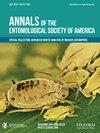Maggot Therapy in Chronic Wounds: New Approaches to Historical Practices
IF 3
3区 农林科学
Q1 ENTOMOLOGY
引用次数: 5
Abstract
Abstract Blowfly larvae of Lucilia sericata (Meigen) (Diptera: Calliphoridae) are well established as debridement agents in nonhealing wounds. Maggot therapy (MT) experienced reduced application following adoption of Penicillin and other antibiotics, but the advent of antibiotic resistance and the growing global wound burden have boosted demand for new therapies. The mechanisms of action are well accepted, with debridement, disinfection, biofilm destruction, and inhibition, as well as the stimulation of tissue growth uniformly acknowledged as a remarkable biotherapy. The mechanisms of action, while well-recognized, are still being examined. The efforts to understand isolated aspects of a complex system, have resulted in a tendency to approach the field from simplified viewpoints that remove the holistic system of the larvae. Furthermore, clinical studies have conflated wound debridement and healing in definitions of ‘success'. Thus, both in vitro and clinical studies have reported mixed results, presenting some uncertainty regarding the utility of MT that prohibits routine clinical adoption. This review builds from the generally accepted basic mechanisms to justify a future for MT that encompasses larval-bacterial symbioses as the basis to a holistic system. Symbioses are well documented in the Insecta, and literature in MT supports the existence of established symbiotic associations that provide enhanced debridement action. The future of MT requires consideration of a biological system that confers enhanced antimicrobial action on larvae when selective pre-exposure to carefully selected symbionts is adopted. In treating contemporary infections, there is much to be gained from reflecting on the natural biology of the organism, as MT was used with success long before we sterilized the system.慢性伤口的蛆疗法:历史实践的新方法
摘要绢绿蝇(Lucilia sericata, Meigen)(双翅目:绢绿蝇科)的飞蝇幼虫在未愈合的伤口中具有良好的清创作用。在采用青霉素和其他抗生素后,蛆疗法的应用减少了,但抗生素耐药性的出现和全球伤口负担的增加促进了对新疗法的需求。其作用机制被广泛接受,清创、消毒、生物膜破坏和抑制,以及刺激组织生长被一致认为是一种显著的生物疗法。这些作用机制虽然得到公认,但仍在审查中。努力了解一个复杂系统的孤立方面,导致了一种倾向,即从简化的角度来看待这个领域,从而消除了幼虫的整体系统。此外,临床研究在“成功”的定义中混淆了伤口清创和愈合。因此,体外和临床研究都报告了不同的结果,对MT的效用提出了一些不确定性,禁止常规临床采用。这篇综述从普遍接受的基本机制来证明MT的未来,包括幼虫-细菌共生作为整体系统的基础。共生关系在昆虫中有很好的记录,MT文献支持已建立的共生关系的存在,这种共生关系提供了增强的清创作用。MT的未来需要考虑一种生物系统,当采用选择性预暴露于精心挑选的共生体时,该生物系统可以增强对幼虫的抗菌作用。在治疗当代感染时,从反思生物体的自然生物学中可以获得很多东西,因为MT在我们对系统进行消毒之前就已经成功使用了。
本文章由计算机程序翻译,如有差异,请以英文原文为准。
求助全文
约1分钟内获得全文
求助全文
来源期刊
CiteScore
4.90
自引率
0.00%
发文量
25
审稿时长
6-12 weeks
期刊介绍:
The Annals of the Entomological Society of America exists to stimulate interdisciplinary dialogue across the entomological disciplines and to advance cooperative interaction among diverse groups of entomologists. It seeks to attract and publish cutting-edge research, reviews, collections of articles on a common topic of broad interest, and discussion of topics with national or international importance. We especially welcome articles covering developing areas of research, controversial issues or debate, and topics of importance to society. Manuscripts that are primarily reports of new species, methodology, pest management, or the biology of single species generally will be referred to other journals of the ESA. The most important criteria for acceptance are quality of work and breadth of interest to the readership.

 求助内容:
求助内容: 应助结果提醒方式:
应助结果提醒方式:


